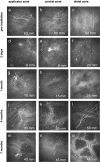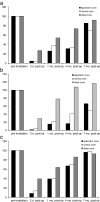Changes in the micromorphology of the corneal subbasal nerve plexus in patients after plaque brachytherapy
- PMID: 23759072
- PMCID: PMC3691838
- DOI: 10.1186/1748-717X-8-136
Changes in the micromorphology of the corneal subbasal nerve plexus in patients after plaque brachytherapy
Abstract
Background: To quantify the development of radiation neuropathy in corneal subbasal nerve plexus (SNP) after plaque brachytherapy, and the subsequent regeneration of SNP micromorphology and corneal sensation.
Methods: Nine eyes of 9 melanoma patients (ciliary body: 3, iris: 2, conjunctiva: 4) underwent brachytherapy (ruthenium-106 plaque, dose to tumour base: 523 ± 231 Gy). SNP micromorphology was assessed by in-vivo confocal microscopy. Using software developed in-house, pre-irradiation findings were compared with those obtained after 3 days, 1, 4 and 7 months, and related to radiation dose and corneal sensation.
Results: After 3 days nerve fibres were absent from the applicator zone and central cornea, and corneal sensation was abolished. The earliest regenerating fibres were seen at the one-month follow-up. By 4 months SNP structures had increased to one-third of pre-treatment status (based on nerve fibre density and nerve fibre count), and corneal sensation had returned to approximately two-thirds of pre-irradiation values. Regeneration of SNP and corneal sensation was nearly complete 7 months after plaque brachytherapy.
Conclusions: The evaluation of SNP micromorphology and corneal sensation is a reliable and clinically useful method for assessing neuropathy after plaque brachytherapy. Radiation-induced neuropathy of corneal nerves develops quickly and is partly reversible within 7 months. The clinical impact of radiation-induced SNP damage is moderate.
Figures




Similar articles
-
Corneal endothelial cell density after ruthenium plaque radiation therapy for iris melanoma patients.Acta Ophthalmol. 2012 Nov;90(7):e577-9. doi: 10.1111/j.1755-3768.2012.02389.x. Acta Ophthalmol. 2012. PMID: 23106862 No abstract available.
-
Radiation related complications after ruthenium plaque radiotherapy of uveal melanoma.Br J Ophthalmol. 1996 Aug;80(8):732-9. doi: 10.1136/bjo.80.8.732. Br J Ophthalmol. 1996. PMID: 8949719 Free PMC article.
-
Corneal sensation and subbasal nerve alterations in patients with herpes simplex keratitis: an in vivo confocal microscopy study.Ophthalmology. 2010 Oct;117(10):1930-6. doi: 10.1016/j.ophtha.2010.07.010. Epub 2010 Sep 1. Ophthalmology. 2010. PMID: 20810171 Free PMC article. Clinical Trial.
-
Decreased Corneal Sensation and Subbasal Nerve Density, and Thinned Corneal Epithelium as a Result of 360-Degree Laser Retinopexy.Ophthalmology. 2015 Oct;122(10):2095-102. doi: 10.1016/j.ophtha.2015.06.010. Epub 2015 Jul 16. Ophthalmology. 2015. PMID: 26189186
-
In Vivo Confocal Microscopy of the Human Cornea in the Assessment of Peripheral Neuropathy and Systemic Diseases.Biomed Res Int. 2015;2015:951081. doi: 10.1155/2015/951081. Epub 2015 Dec 7. Biomed Res Int. 2015. PMID: 26770980 Free PMC article. Review.
Cited by
-
The diagnosis of limbal stem cell deficiency.Ocul Surf. 2018 Jan;16(1):58-69. doi: 10.1016/j.jtos.2017.11.002. Epub 2017 Nov 4. Ocul Surf. 2018. PMID: 29113917 Free PMC article. Review.
-
[Morphometric characterization of the subbasal nerve plexus : Detection and analysis of networks of nerve fibers].Ophthalmologe. 2017 Jul;114(7):608-616. doi: 10.1007/s00347-017-0465-3. Ophthalmologe. 2017. PMID: 28224218 Review. German.
-
Post-photorefractive Keratectomy Pain and Corneal Sub-basal Nerve Density.J Ophthalmic Vis Res. 2017 Apr-Jun;12(2):151-155. doi: 10.4103/jovr.jovr_100_16. J Ophthalmic Vis Res. 2017. PMID: 28540005 Free PMC article.
References
-
- Char DH, Quivey JM, Castro JR, Kroll S, Phillips T. Helium ions versus iodine 125 brachytherapy in the management of uveal melanoma. A prospective, randomized, dynamically balanced trial. Ophthalmology. 1993;100:1547–1554. - PubMed
MeSH terms
Substances
LinkOut - more resources
Full Text Sources
Other Literature Sources
Medical

